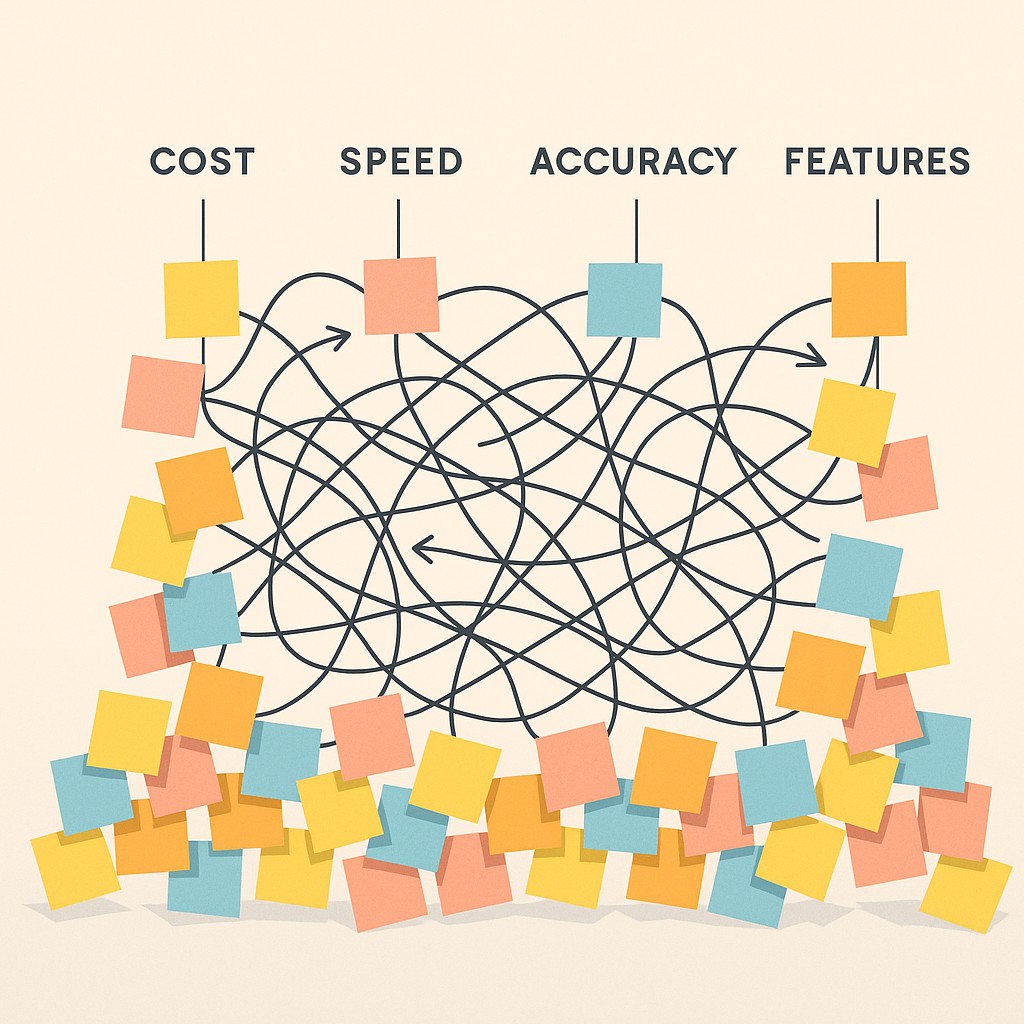How to Prioritize Ruthlessly: The Playbook for Non-Negotiable Outcomes
How to Prioritize Ruthlessly: The Playbook for Non-Negotiable Outcomes

When Everything Is a Priority, Nothing Stands Out
Last quarter feels like a bad rerun now. We pushed out a release I was almost proud of—right up until I saw the demo flop. Cost targets, performance specs, and user feature requests were all jumbled on my roadmap. I tried to optimize for everything: limited GPU hours, shaving milliseconds off latency, hitting accuracy stats, not to mention squeezing in two must-have features that sales said would close deals. I spent way too much time bouncing between spreadsheet columns, chasing numbers that felt almost right. At the time, I thought we’d nailed it.
Then came demo day—users shrugged, the team looked tired, and our big features just sat there, neither bold nor memorable. I remember staring at my own slides, thinking, Is this really it? We’d built something that satisfied nobody.

Here’s what stings most: not knowing how to prioritize ruthlessly leads you to placate every stakeholder and optimize for every “must-have,” and your focus scatters. It’s exactly why you must avoid scope creep: it burns up energy and stretches timelines until you start losing track of why you shipped anything at all. Focused teams hit their business goals on 72 percent of projects, with just 28 percent encountering scope creep and less budget lost when failure did happen. Turns out, scattered priorities are more than exhausting—they’re expensive. I wish I could say I learned this instantly, but it was a painful lesson: chasing everything often means achieving nothing.
Patterns repeat themselves. I used to think I could just add “one more feature” or chase a last-minute request, no big deal. But every time, quality slipped. The codebase got that swollen, messy feeling. What shipped felt diluted, and stakeholders ended up indifferent. After a while, even I wasn’t thrilled. Each compromise made in hopes of pleasing everyone was really a recipe for disappointing everyone.
Sometime last year, Herbert Bayard Swope’s line started to echo in my head: “I can’t give you a sure-fire formula for success, but I can give you a formula for failure: try to please everybody all the time.” I wish I’d believed that back when I started. It changed how I thought about what counts as “good work.”
Steve Jobs offers the same punch from a different angle: “Focus isn’t about saying yes to the things you should do—it’s about saying no to everything else.” Over time, these quotes got under my skin, helped me realize focus is as much about what you ignore as what you pursue. There’s real conviction in ruthless focus, even when it feels risky.
Why Over-Optimizing Spreads Us Thin
Let me spell out what happens when you try to optimize everything at once. You’re thrown into a technical problem that demands intentional trade-offs among three clashing aims—speed, accuracy, and cost. Split your energy between all of them, and you don’t maximize any of them. You get latency that’s “fine,” accuracy that’s “decent,” budgets barely intact. I remember running our model training this way, hoping to keep every metric happy. The gradient never climbed; it just flattened. I kept telling myself, maybe next time we pick one. Eventually, I realized—if you want a win, you have to decide where you’re going to win.
Worse, every stakeholder wants their own spotlight. Data science wants accuracy, infrastructure wants budget safety, sales wants shiny features upfront. I don’t have a formula for clear success—but I do know how failure sneaks in: try to please everyone and watch the letdowns come rolling in. If you’re stuck in this loop, you’re very much not alone.
What actually changed things: excellence isn’t just refusing to spread thin—it’s practicing ruthless prioritization. It’s knowing how to trade off. For me, it started with picking which outcomes genuinely mattered each time. You draw a thick line around those, and say no—loudly—to everything else. When I finally committed, our team’s throughput didn’t trickle, it jumped. Suddenly, our energy was on one track. Even standups felt lighter.
That compromise launch—the one nobody cared about—still bugs me. But it convinced me: concentrated resources on a chosen priority beat scattered hope every time. Credibility’s earned by getting uncomfortable and saying “no” to what doesn’t advance the goal.
And just to say—this isn’t foolproof. Some weeks, it still feels like priorities are vying for attention, like kids singing off-key. I haven’t figured out why saying “no” seems tough even when you know it’s right. Maybe it’s just how we’re wired.
How to Prioritize Ruthlessly: The Playbook for Non-Negotiable Outcomes
Here’s how to prioritize ruthlessly in actual sprints. First, define just two or three non-negotiable outcomes—no more. These aren’t wishlist items; they’re deliverables the team signs their name to. Assign clear metrics so there’s no fudge room about what “done” means. Then, dump most of your resources—hours, firepower, headspace—into them. And here’s the bit most folks skip: write what you’re not doing, right next to your goals. I slap this list on my sprint doc and share it in planning. Once I did this, the backlog and calendar actually made sense. Doesn’t need to be clever—just dump out every “no,” from tempting refactors to features that constantly pop up as distractions. Once it’s public, the team stops guessing what’s in bounds.
Non-negotiables have to move your product or your business forward—not just score popularity points. I hunt for things that push our user metrics, retention, or whatever matters this cycle. If a feature doesn’t shift big numbers, it becomes a “later.” Priorities start making sense once you treat them less like votes and more like levers for progress.
Drawing boundaries isn’t enough. You actually have to hold them up. Make your not-doing list public. Bring it to standups, defend it during triage when people ask—remind yourself, “Does adding this help us deliver on our outcomes?” At first, saying “no” made me feel like I was letting someone down. Turns out, it’s a promise. We ship what matters, period. After a few cycles, trust builds. The work gets sharper.
The trickiest bit is saying “no” live. I started using blunt scripts. “If we take on this feature, we’ll miss latency goals—do we want that tradeoff?” Honest and simple. It’s not easy, but it beats the pain of another diluted sprint. I wish I’d tried it years ago.
Try this habit. Every Friday, scan your week’s commitments. Find one “yes” you could flip to “no.” It’s saved me from sliding back into chaos, more times than I care to admit. You end up shipping work that’s focused, actually useful, and finished—minus the churn.
Saying No Builds Stronger Products (and Teams)
Here’s the real fear. When you learn to say no, someone—maybe sales, maybe your boss—gets annoyed. I used to tense up every time I pushed back, convinced I’d ruin trust. The shift happened slowly: every “no” isn’t a rejection. It’s defending the work you promised. Now I try to translate “no” into a visible choice: “We’re picking X because that’s the fastest way to deliver real impact.” It’s not dodging. It’s owning what matters.
I should admit something here. Saying yes was second nature for me. I once took on a weekend side project just because I wanted to help a friend. By Monday, I was foggy, the sprint lagged, and my main work suffered. Different project, same drift—the “yes” list grows, focus blurs, results fade. Saying yes feels good in the moment. But every time I do it, the main goal loses a bit of oxygen.
Actually, it reminds me of that time in college when I signed up for three club committees, convinced I could handle it. One was a robotics project that needed serious attention. Another was basically organizing snacks for meetings—and somehow, that soaked up more hours than I’d admit. End of the semester, the robot was half-baked, nobody cared about the snack schedule, and I mostly just felt exhausted. Not exactly a lesson you find in product textbooks, but the analogy stuck.
It’s like loading a plane for takeoff. Try to cram every bag aboard, and you never leave the runway. In product, “shed weight” means pushing features to later. You only take what’s needed to get airborne—and maybe skim off meetings that just slow the climb.
The data backs this up. Teams that limited work in progress cut cycle times by 42 percent—from 71 days to just 43 days (AWS case study). That’s when trust starts to show up. We noticed it—shipping fewer things, but better, earned credibility fast.
If saying “no” still feels risky, remember: focused execution isn’t just for the product. It’s your reputation. Stakeholders notice when you ship what counts. So does your team.
The Sprint Routine That Actually Builds Focus
Here’s the rhythm that keeps my team on track. For prioritization for engineering teams, start your sprint with two or three outcomes that cannot budge. Spell out what winning looks like for each—whether that’s sub-100ms latency, top-tier user feedback, or knocking down GPU hours. Right next to those, write down what you’re officially “not doing.” It might go on your Slack status, on the wall, wherever you’ll see it. Personally, once I set a hard GPU budget and shoved a bunch of side experiments into my “later” pile, everything changed. Scope stayed tight. Progress kept moving.
Each morning, I do one check: “Does the task in front of me push a chosen outcome forward?” If I hesitate, it gets a “not now” sticky note. There’s real science behind this—switching tasks kills your focus and performance on complex work drops. That’s why I run this check before my first standup, just to protect any deep work hours. Anything off-course, I reclaim the time.
Trying to do everything leads to mediocrity, not mastery. When we try to please everyone, we please no one. I still catch myself overextending sometimes; the “yes” reflex is persistent. But I’m convinced: the courage to say “no” gives your best work actual room to breathe.
Ship fewer, better outcomes, and let our app handle the writing: generate AI-powered content in minutes, tailored to your goals, constraints, and tone, so you can keep your focus on building.
Before you shut down today, pick one lingering “yes” and flip it to “no.” See how tomorrow feels with clearer ground beneath you.
Back to that museum of compromises I mentioned before… Some part of me still wants to keep every stakeholder smiling. But if I’ve learned one thing, it’s that progress means letting go—one hard “no” at a time.
Enjoyed this post? For more insights on engineering leadership, mindful productivity, and navigating the modern workday, follow me on LinkedIn to stay inspired and join the conversation.
You can also view and comment on the original post here .
